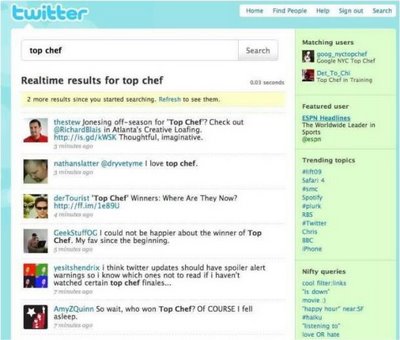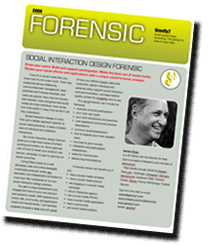I'm most intrigued by the notion that in a social space like twitter, which is fundamentally open, might accommodate structure and organization on-the-fly. Twitter's lack of social organization stands in contrast to the contained and persistent presence and relationship structure of Facebook. Facebook not only guarantees a higher level of attention and visibility around user actions, its super social activity-oriented architecture and design allow the company to offer developers templates for social interaction, a means of distribution among friends, and feeds by which to publish activity and participation.
Twitter, on the other hand, is built around asymmetrical, often un-reciprocated member relationships. it's activity stream is organized only by time, not by space or application as it is on Facebook. It has virtually no symbolic languages or gestural systems, and few means of routing and addressing communication, not to mention differentiating it aside from what the user says.
Where Facebook has raised the bar for social actions, Twitter remains primarily a communication space. But in the real world, a great variety of forms of talk exist to organize social relationships and various "kinds of doing" (as Goffman would put it). These have been categorized by sociologists as rituals, ceremonies, pastimes, games, and intimacies. They rely more heavily on unwritten but tacitly understood codes of conduct and behavior. But like social action systems, they involve sequencing, turns, addresing, the distribution of attention, and constraints on behavior as well as speech.
So, could talk-based social action systems be in twitter's future? We've seen hints of this already. Indeed it seems almost inevitable that an open system for talk like twitter would show signs of self-organization, and the emergence of social practices having more structure than the ubiquitous baseline tweet. We would need only twitter apps and services that mine relationships, connect the unconnected, and introduce topical or other kinds of speech-based forms to organize and order activity and participation. On twitter, these might be on the structures designed to work on-the-fly, or to persist over time.
Here's a quick look at how we might approach the field.
The design of social interactions around twitter presents some interesting challenges. We can bundle these into conceptual categories that pertain to the design of openly-structured social media in particular.
- Social organization: organizes participants, defines roles, positions, rank, results, and so on
- Activities: organizes the tweet-based activities, both communication and action based
- Meta: presentation layer for activities, using tweets, twitterers, relationships, data, and content as source material
Social organization
Relationships on twitter can be established without mutual consent (I follow you, you don't follow me back). This means that many are asymmetrical. Asymmetry probably increases the incidence of transient relationships (I follow you for a while, unless you follow me back). Higher transience corresponds to a lower commitment barrier, which might enable passing and temporary relationships with others for reasons other than friendship and genuine personal interest.
This suggests that in theory at least, a relationship could be used temporarily for social organization or activity structure (say, for the duration of a game).
Associative and informal relationships can be suggested by mentioning a person in a tweet. This suggests that passing and temporary relationships of affiliation or association could be used for social organization (say, to create a team).
Groups and audiences. Followers of a twitter @username or those associated with hashtags (categories; see what wefollow is doing) could serve the purposes of transient or temporary social activities. Again, fans and teams come to mind.
Activities
Conversational/Communication-based activities would require users to include terms or phrases required to further a game or social interaction. The possibilities here are endless, from the poetic to the informational, quantitative, descriptive, instructional, normative, and much more. Games or activities could be built around "speech acts" that do or accomplish something, trigger, launch, start, iterate, repeat, or close a run of action, a series of moves, even an operation. (Many ceremonies are carried out by means of following a script.)
Social Action based activities would require not only the saying of things but saying them in order, or addressed to particular "players." The distinction between communication and social action is that the tweet would just be a "move." Tweeting would perform the move. A game would might use a code or set of rules that is played by tweeting. One could play chess quite easily using twitter. Rules of interaction could be designed around the moves, responses to moves, sequencing of moves, who moves, and so on. Again, the possibilities are endless.
Meta
Visualizations could be used to show what is happening across those playing or participating in a twitter-based social game. Tweets might be represented as they are. Or their authors might be represented. They may be shown by attributes, location, historically relevant information, by relation, activity, and so on. Or tweets might be used to control a visualization (much as font sizes are coupled to volume in tag clouds). Real time games could even be played around twitter real-time search results. Data mined from tweets, twitter users, and relationships could be used to bind or constrain games and to design rules of play.
Trends would be very easy to make interactive on twitter, as the timeline is fast participation is easy. Real-time polls and trending lend themselves to twitter. Visualizations could be added to capture results, and also to create interaction systems and controllers. Tweets might be used to create content that is then re-purposed for social gaming. Just think of the many quiz shows, trivia games, and real-time polls that are common on tv and in some online social games...
These are just ideas for how twitter could be used for more structured and organized activities. I thought it might be fun to voice some of this o flesh out the ideas and to delineate some of the structure that is implicit in twitter and in talk in general. I can see these happening, although it's possible that twitter's strong sense of public space will act as a constraint. But it wouldn't surprise me if some brand, some time, creates a hit.
Labels: social interaction design, status culture, twitter, user experience







